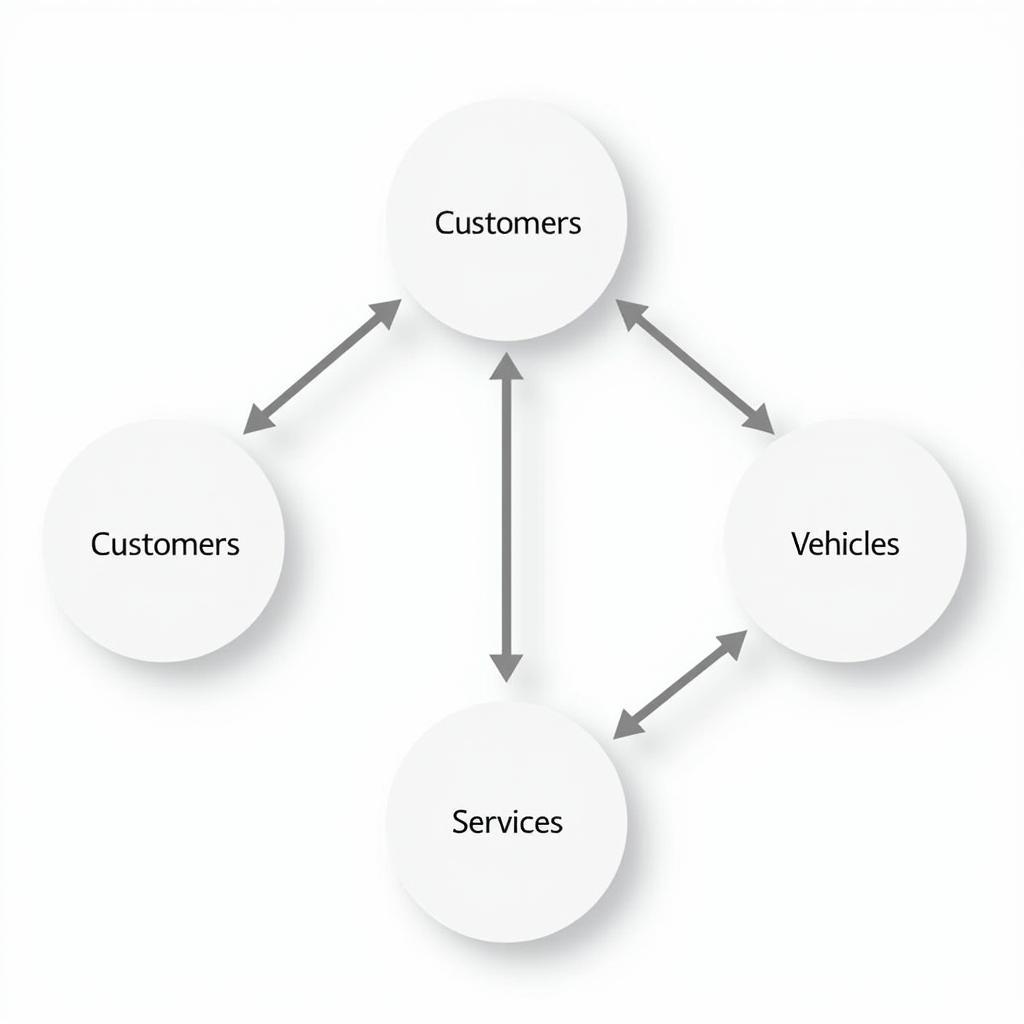A car service center ER diagram visually represents the data structure and relationships within a typical car service operation. Understanding this diagram helps streamline operations, improve data management, and enhance customer service. It provides a blueprint for designing a database that effectively tracks customers, vehicles, services, parts, and employees.
Understanding the Core Entities
The core entities of a car service center ER diagram are crucial for capturing essential information. These entities interact with each other to form a complete picture of the business process. They include customers, vehicles, services, parts, and mechanics. Let’s explore each of these in more detail.
Customers
Customers are the individuals or organizations who bring their vehicles for servicing. Key attributes include customer ID, name, contact information, and address. Understanding customer demographics and service history can help personalize services and improve customer loyalty.
Vehicles
Each vehicle is identified by its Vehicle Identification Number (VIN), make, model, year, and other relevant details. Tracking vehicle service history is critical for efficient diagnosis and preventative maintenance. What services has the car had? When were they performed? This information helps provide a comprehensive service history.
Services
Services represent the various tasks performed by the car service center, such as oil changes, tire rotations, brake repairs, and engine diagnostics. Each service has a unique ID, description, and price. Clear categorization of services allows for precise tracking and billing.
Parts
Parts represent the components used in servicing vehicles. Each part has a unique ID, name, supplier, and cost. Accurate inventory management of parts is essential for cost control and ensuring timely service delivery. Are certain parts frequently used together? This information can be tracked and utilized for more efficient inventory management.
Mechanics
Mechanics are the skilled professionals who perform the services. Each mechanic has an ID, name, specialization, and hourly rate. Tracking mechanic performance can help identify areas of expertise and optimize resource allocation.
Relationships Between Entities
The relationships between entities define how they interact within the system. For example, a customer owns a vehicle, a vehicle receives a service, and a service uses parts. These relationships are crucial for data integrity and querying the database efficiently. Understanding these connections allows for a more nuanced understanding of the business operations.
Cardinality and Modality
Cardinality and modality define the number of instances of one entity that can be associated with instances of another entity. For instance, a customer can own one or many vehicles (one-to-many relationship). A vehicle can receive many services over time. These relationships and their constraints are essential for building a robust and accurate database.
Advanced Concepts and Extensions
Expanding the ER diagram with additional entities like appointments, invoices, and payments further enhances the system’s functionality. This detailed representation provides a more comprehensive overview of the car service center operations.
Appointments
Including appointments allows for better scheduling and resource management. Tracking appointment times, dates, and services requested helps optimize workflow. This allows for more efficient use of time and resources, leading to improved customer satisfaction.
Invoices and Payments
Integrating invoices and payments allows for streamlined billing and financial tracking. This data is essential for reporting and financial analysis. Linking invoices to services and parts provides a clear breakdown of costs.
Conclusion
A well-designed Car Service Center Er Diagram With Explanations is essential for effective data management and efficient operations. It provides a visual representation of the data structure and relationships within a car service center, allowing for better understanding and optimization of the business process. By implementing a database based on this diagram, car service centers can enhance their services, improve customer satisfaction, and streamline their operations.
FAQ
-
What is an ER diagram?
An ER diagram is a visual representation of the entities and relationships in a database. -
Why is a car service center ER diagram important?
It helps organize and manage data related to customers, vehicles, services, and parts efficiently. -
What are the core entities in a car service center ER diagram?
Customers, vehicles, services, parts, and mechanics are the core entities. -
What is cardinality in an ER diagram?
Cardinality defines the number of instances of one entity that can be associated with instances of another entity. -
How can an ER diagram improve car service center operations?
It allows for better data management, efficient scheduling, and streamlined billing processes.
Need help with car diagnostics? Contact us via WhatsApp: +1(641)206-8880, Email: [email protected]. We have a 24/7 customer support team.


